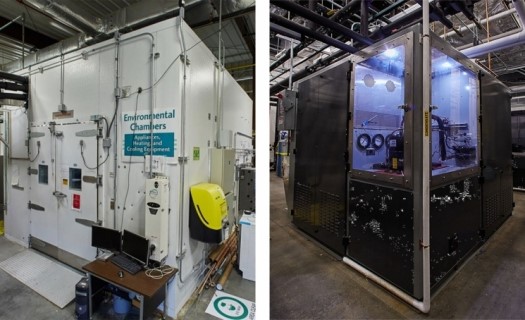What is an HVAC System?
Heating, Ventilating and Air-Conditioning (HVAC) systems are an important part of any building such as residential (homes, apartments, condos, etc.), commercial buildings (e.g., hotels, hospitals, schools, universities, office buildings, etc.) and industrial buildings (factories, warehouses, manufacturing plants, etc.). Building performance and sustainability trends have raised interest in HVAC systems.
They help in controlling the temperature, humidity and air quality to provide comfortable indoor environment to both residents and equipment in the buildings.
- Heating is accomplished by heating the air within the building using radiators or supply air systems.
- Ventilation is achieved by maintaining clean air in the space and extracting polluted air out of the space. It also keeps internal air circulating and removes excessive moisture. This is usually accomplished by mechanical systems powered by fans.
- Air-Conditioning lowers the temperature and maintains appropriate humidity levels using air-cooled or water-cooled systems.
An HVAC system aims to provide an environment in which the following factors are maintained within a desired range:
- 75 degrees Fahrenheit
- 40 – 60 % relative humidity
- ASHRAE 62.0 ventilation standard or CO2 less than 1000 PPM
According to the U.S. Small Business Administration, HVAC systems account for about 40% of energy usage in commercial buildings. Consequently, the goal of any commercial building owner and government agency is to improve the HVAC efficiency to reduce costs, energy consumption and greenhouse gas emissions.

Types of HVAC Systems
HVAC systems are very important during the architectural design of a building for the following reasons:
- The success of an HVAC system is directly related to the building’s comfort levels.
- HVAC systems require substantial floor space for housing the unit/units as well as the distribution equipment.
- HVAC units required significant investment
- HVAC systems form a large portion of the building operating expenses
There are a number of HVAC systems used in buildings. Here, we will present a few types generally used in US commercial buildings. This is not an exhaustive list of all variations present in buildings.
The types of HVAC systems in commercial buildings can be divided into three broad categories:
1. Centralized: As the name implies, a centralized system is a single system that supplies the HVAC needs of the building.
The centralized system is generally located in a single zone. These systems are consolidated units and typically use water as a cooling medium and use extensive ductwork for air distribution. The advantages of the centralized system are better to control and have greater load-management potential. The major disadvantage is these are expensive to install and are more sophisticated to operate and maintain.
2. Packaged: Packaged HVAC systems are often used in buildings without adequate space for all the separate components. Packaged heating and air conditioning systems are available together in one packaged unit. Packaged HVAC systems generally contain the following:
- The air conditioner/heat pump together with the evaporator/fan coil in one unit
- Control/Thermostat interface for a complete control of the system
- Optional air quality improvers. Things like the air purifiers, cleaners, ventilators or UV lamps, which gear towards making the air extra clean before it circulates your home or office.
3. Individual: Individual or decentralized systems provide energy using various individual units in various locations of a building.
Examples of self-contained unit packages are rooftop HVAC systems, air conditioning units for rooms, and air-to-air heaters.
The advantages of individual units are they are easy to control and have lower investments initially. However, in large buildings, individual systems can become a maintenance nightmare if you have many systems distributed across the building. It is important to consolidate systems that are likely to break or leak and expensive to replace, and distribute the other things like fans, and terminal devices.
Below is an image of a highly advanced centralized HVAC system in a building:

HVAC Systems and energy Efficiency Improvements
Due to the fact that HVAC systems account for the high-energy usage in buildings, every facility can avail increased energy and cost savings by improving the HVAC operations through proper design, installation, scheduled maintenance and other activities.
The following section presents an outline of some suggestions to improve your facility’s HVAC system efficiency:
1. Designing: HVAC system design goes hand in hand with the architecture of the building. Deciding on the HVAC design as early as possible ensures that energy code requirements as laid out by Department of Energy are met. This requires including the entire building’s architectural and engineering requirements into the consideration of an ideal HVAC system.
It is also important to keep in mind, the safety factors of installing a large equipment. Sizing is another consideration, wherein; HVAC systems are properly sized including allowance for uncertainties. This would prevent excessive and wasteful capacity by utilizing modular equipment that can be expanded in future, should the need arise.
2. Tuning: It is recommend to schedule bi-annual maintenance on your HVAC systems by licensed personnel. The general maintenance tasks are as follows:
a. Replacement of air filters
b. Clean transfer coils in heat pumps, air conditioners and chillers.
c. Inspect ducts and piping to avoid leakage and damages.
d. Inspect and repair air ducts and fan motors.
e. Check your furnace annually
3. Efficiency Settings: Substantial savings can be achieved by adjusting temperature setpoints —lower setpoints in the winter and higher temperature setpoints in the summer. One of the ways you can save on your HVAC bills is to optimize the operation of the system. Setting the system off when the building is not occupied can do this. Utilizing the “Auto” mode to let the fan run only when heating or cooling is being provided is an effective setting.
4. Programmable thermostat: HVAC loads vary through a 24-hour period as well as in different parts of the building. A programmable thermostat can automatically control to switch on air in rooms that are occupied, switch off during off-peak hours as well as to program desired setpoints. Ensuring that the thermostat is place in a location where the temperature is representative to the entire area is essential. It should be particularly not place next to an air-conditioning unit, heat vent or computer and electronic equipment.
5. Energy Management System: Energy management systems (EMS) or Building Energy Management Systems (BEMS) are computer controls that monitor and control a building’s HVAC and other energy systems. Software controls the HVAC system and provides notifications and alarms when the HVAC system is not operating efficiently. BEMS are often used in large and complex buildings as well as multi-site buildings.
These systems are capable of controlling many different functions in a building and include intelligent reports to help identify problems and trends, provide recommendations for fixes and integrate control systems to automate responses.
Some automatic control features include:
- Adjustment of air temperatures based on indoor and outdoor temperature and humidity to let heating and cooling systems operate most efficiently.
- Adjustments are required whenever you need cooling in the building but the outside temperature is low. With an economizer mode, your system can circulate outdoor air for free cooling during these periods.
- Implementation of holiday period automatic setpoint adjustments.
- Monitor temperatures to minimize overheating or overcooling of spaces.
An EMS can be used to control other functions in your building as well, such as lighting, fire suppression and security. It can manage your electric loads, prevent peak loads and optimize your electrical rate with your electric utility. EMS suppliers typically estimate that an EMS can cut the heating and cooling bills of a business with a central chiller and heating system by 10 to 50 percent, with many estimates clustered around the 20 percent range
6. Upgrading your system:
A HVAC unit for a commercial building is usually expensive; hence, it is not recommended to replacement if it is not in good working order. However, if there is significant energy loss and it is nearing the end of it’s life, you can consider replacing it to support preventive maintenance and benefit from energy savings.
A scheduled replacement can generally be negotiated at a lower cost and with less inconvenience than the emergency replacement of a failed unit.
If you plan to upgrade any heating or cooling equipment, this has to be done after other energy upgrades have been implemented. Other modifications such as lighting replacements or building construction improvements may result in a change in size requirements for your new HVAC system.
It is not recommended to buy oversized HVAC equipment by overestimating the capacity. Grossly oversized heating and cooling equipment will cycle too often and will be unable to sufficiently dehumidify your space, which creates a serious comfort issue. It will also cost more to run annually.
Conclusion
In conclusion, a HVAC (Heating, ventilation, and air conditioning) system is a very important component of a healthy, comfortable, and energy-efficient building. There are various types of HVAC installations depending on the location and size of a building. The three common types are centralized, packaged and individual or decentralized. Since HVAC systems are the largest energy consumers in a building, it is important to ensure that energy efficiency methods are in place to ensure reduction in energy consumption, costs and greenhouse gas emissions.



